Well, October is a few months away, so it’s time for Hollywood to start rolling out the Halloween movies! This year’s spooky pregame is Scary Stories to Tell in the Dark, an adaptation of the children’s series that scarred a generation forever (in the interest of transparency: that includes me). Guillermo del Toro, maestro of the grotesque, lent a producing hand, and early clips showcased faithfulness to the book’s illustrations—what do these good omens portend? Have the hallows come early?
In the small town of Mill Valley, it’s right on time. Scary Stories opens on October 31st, 1968, following a group of friends who break into a haunted house, steal a book that was written in children’s blood, and then have the audacity to act surprised when bad things start happening to them. None of these events actually occurred in the original series: the books were anthologies of short, unrelated stories. This style of storytelling is unthinkable for the Hollywood of cinematic universes, though, and so five screenwriters have stitched together a narrative framework to connect the books’ most enduring tales.
When Scary Stories gets around to telling scary stories from “Scary Stories”, it sticks the landing with an admirable squelch. The body horror of the novels is translated to the screen immaculately, ensuring that your fear is accompanied by a healthy dose of nausea. The special effects and creature design keep the spirit—or the ghoul, rather—of its source material intact. The movie’s best moments are ripped straight from the books.
The framing narrative, unfortunately, is ripped straight from every other book. It’s a checklist of clichés, horror and otherwise. Let’s see—protagonists who can each be summed up by one adjective, a cursed book that can’t be burnt or thrown away, an elderly black woman who’s accused of practicing black magic, misrepresentation of psychiatric treatments, a scene where pursuers run past a character’s hiding place while shouting “he went this way!”—it’s all accounted for. And Scary Stories isn’t tongue-in-cheek about its trope parade, so the satirical joys of Scream and Cabin in the Woods are nowhere to be found. That’s quite a missed opportunity for a movie about written stories coming to life. The characters have built-in expectations about their own hauntings! Play with that!
But the movie just trips over its tropes until it falls into the next monster. There’s maybe forty minutes of greatness here, but it’s bogged down by an hour of pointless connective tissue. Scary Stories would’ve been better off just introducing each segment with a title card. The overarching narrative does try to build a thematic message—allusions to Nixon’s election and the Vietnam War are very frequent, and very blatant—but it doesn’t go further than “war is the real horror!” and “needless death is not a good thing!” Why include an allegory if it’s too undercooked for cinephiles and too extraneous for horror buffs?
The latter group might be satisfied by some scares, but the movie is louder and jumpier than it is genuinely disturbing. You’ll get the most mileage out of Scary Stories if you grew up with the books, but even then, most of the movie is (un)original material. Why does it exist, then? Who is this—oh, a cliffhanger ending. A franchise it is, then.
★★ (2/5)




